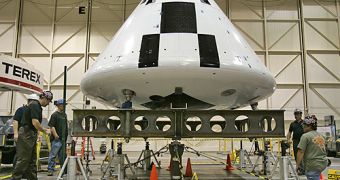The latest of NASA's crafts, the Orion space capsule unveiled at the space agency's Dryden Flight Research Center from the Edwards Air Force Base, is currently undergoing first tests. If all goes well, this will serve as a prototype for the actual spacecraft, perfectly identical but including all the improvements that must be done following the results of the tests, which will be built at the Lockheed Martin Space Systems in Littleton, Colorado.
The Orion capsule looks strikingly similar to the Apollo 11 craft that took American astronauts Neil Armstrong, Buzz Aldrin and Michael Collins to the Moon and back to the Earth almost 40 years ago, in 1969. If you're wondering why NASA didn't rely on the space-plane design of the other shuttles (Discovery, Endeavour, Columbia, etc.), their reply was that the plane-like design was too vulnerable to flying debris. Looking back to what happened in 2003 to the Columbia shuttle (which disintegrated upon atmosphere reentry after colliding with a piece of foam insulation material torn from its external tank), it is easy to accept this as enough of a reason.
The Orion module is primarily scheduled to transport a human crew to the Moon by 2020 and later on to Mars, possibly after 2030. Although it is very similar to the Apollo module, the major difference between the two is that Orion's bigger size (16.5 feet – 5.03 meters diameter compared to Apollo's 12.8 feet – 3.9 meters) will allow it to accommodate a larger crew (six people comparing to three on Apollo) “pretty cozy,” as Gary Martin, the project manager for the test program claims. “This is the same shape as Apollo. But the extra space translates into twice as much volume as Apollo,” he added.
This version of the space vehicle weighs about 14,000 pounds (6.35 tons), but considering that the final product will also contain dozens of devices, instruments and flying apparatus, it will eventually reach a weight of about 17,000 pounds (7.71 tons). In the final phase, before launch, it will sit atop the new Ares rocket designed by NASA.

 14 DAY TRIAL //
14 DAY TRIAL //